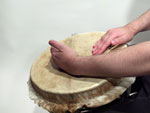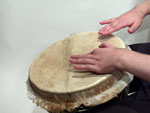
: : : Percussions : : Mandingo : Instruments
The djembe
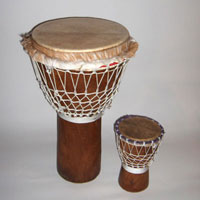
The word "djembe" means "drum" in Bambara, the main language of Malian communities (or "Mandingo"). It refers to a hand drum (played with fingers) whose shape was inspired by the mortar of these regions in West Africa (with the culinary tradition of crushing the seeds just before eating), with a hole going throughout (so that the air escapes, and thus the sound). For Mandingo musicians specialized (musical practice is not amateur here, traditionally, which demonstrates its social importance and musical sophistication), whose role often sacred is linked to symbolic rites and social events, djembe represents by its materials already, all the main elements of the universe: the wood for the plant, the skin for animal and the iron for mineral (air is finally the sound itself, just as the soul , emotion, mind and body of the player is transmitted through the instrument, like any other human interpretation of the music, anyway).
The top of the drum has a truncated ovoid shape, and the bottom, the shape of a truncated cone (diameter of the edge of skin: from 7 to 16 inches). This complex form (also called "goblet" or "chalice" shaped, which is imprecise, because also refers to the shape of Near Eastern darbukas, which may be substantially different), implying an improvement in the range (amplitude between the lowest note and the highest), emphasizing the treble near the edge and the bass near the center a bit as a harp or piano does. The djembe is moreover probably the drum with the largest range in the world (often large-sized), making it an ideal instrument for solo by itself (there are few musicians who feel the need to play several djembes at the same time, unlike the congas or modern drumset for example). Its shape is very similar to that of Arabic darbukas which are in terracotta (in Maghreb, close to a vase pierced and returned with related curves), metal (or "Dumbek", in Turkey), or wood with nailed skin (Persian "Zarb").
The djembe drum is hand carved from a single piece of wood (a tree trunk in the direction of the wire), and sometimes decorative reliefs are carved on its periphery. The woods used are African red wood (ferruginous (iron oxide = rust present in the clay), which gives certainly them their "bright" sound) such as mahogany ("djala" (very red, real mahogany, also used for furniture for its splendid aesthetic), "Lingue" (orange-red, less dense, more common), "dugura" (brown, very dense and rare), or "Gueni" (brown with contrasting veining, used for the bars of balafon a sort of Mandingo xylophone)). They are so dense that they are rotproof without treatment: traditional djembes are not varnished, just dried, sanded and greased (with shea butter, beeswax or linseed oil, a good protection against variations in humidity and temperature). Also very robust, it gives excellent qualities of resonance and response, while keeping dullness of sound, richness of tone (facilitating the differentiation of types of strokes), an exceptional balance between roundness and drought (the balance and richness (complex form) are also in my opinion the attributes of organic materials and left almost raw).
The skin (goat skin shaved, formerly of antelope, a protected species today) is stretched by two forged iron cylindrical hoops wrapped in fabric (dyed cotton), with ropes (cotton or nylon, more recently). The hoops, of identical size and adjusted to each other, must grip the skin like a jaw. An ingenious system of tension rope braiding, and a large number of "rods" (from twenty for smaller djembes (for children) to thirty for larger) allows a very high tension, although only achieved by manual force.

Some modern djembes are equipped with metal rods which, if the drum skin and shell kept all the traditional characteristics (material, shape, shaping), would not alter the sound. But in general these drums are also "made" by machines, assembled glued staves (French technique of cooperage in Cuba), as congas and bongos, and varnish, which gives a purer sound, dry and crystalline. This is why I recommend the traditional djembes, which goes hand in hand with the perpetuation of an artisanal original practice (which also varies slightly from one region to another: Senegalese djembe have a foot which widens downwards, for example, and Malian have a foot almost cylindrical or conical truncated). The only innovation that I recommend and which is quite commonly used by professionals, is to replace the cotton ropes, more fragile, with ropes of the same thickness in nylon (look carefully the original rope weaving before doing it). Some use modern pre-stretched mountaineering ropes (usually with nylon, precisely).
As for all natural skins, porous, the mounting (setting on the shell, with the hoops without tension) is made after having soaked the skin (even cleaned, but do not soak longer than a few hours, or it may rot). After drying, the pressure may be important without the clamp between the two hoops damage it or make it slide. It will only remain then after setting and braiding (tension) of the tension rope passed in zig-zag in upper hoop rope, to shave the goat hair with a razor blade positioned perpendicular to the skin, if necessary (you can avoid shaving the hairs that exceed from the hoop, used to protect the hands against shocks on the rods), or cut it along the edges with scissors. Hence, the djembe skin is very sensitive to humidity and air temperature changes (unlike conga skin, which is oiled). Originally conceived for warm and dry climate, and play with fingers, you should be very careful to exposing it nor water, nor sticks (almost sure destruction). To remove the moisture before playing (which gives clearer and dryer sound: the skin vibrates better), the djembe is placed in front of a wood fire (not too close) traditionally, but an electric heater can suit (beware to excess of tension which may then break the skin).
A good djembe shell, the most important part of the drum should not be cracked, and have an upper edge (in contact with the skin) well rounded at all levels (well circular for balanced tension and well rounded from the horizontal to the vertical, to enable the skin to slide over the shell to be stretched, and hit the edge without injury).

You can play sitting, djembe placed between the legs (which can be crossed), slightly leaning forward or standing, with a strap tied around the waist and both shoulders, the shell between legs apart.
The position of the body should be straight and symmetrical, like the playing techniques. Some djembefolas add some ringed metal plates around the drum ("sesses"), to give a continuous sound of "rattle" at each stroke, even piano, and thus increase the effect of number.
The "djembefola", is a master in the art of playing the djembe. This is the one that plays improvised fortissimo choruses of the polyrhythms, but it is also often a soloist who has the ability to mimic all Mandingo polyrhythmic section by himself, playing a continuous accompanying basic phrase "piano", and by inserting accents and even whole solos phrases, "fortissimo", while playing the corresponding parts of basic phrase in the rests of the chorus (illusion of two voices). Its basic phrase can even be a mix of djembe figure and dununs figure (listen to Mamady Keita or Inza Diabate, for example, which may have been pushed into this art by accompanying voice or Kora (sort of African harp) a bit like the pandeiro towards the voice and guitar in Brazil).
The striking techniques of djembe, very sophisticated, are a priori as endless as the number of positions of the hand and fingers.
Traditionally, there are four main types of hits (in the accompanying figures, it is important to be consistent and symmetrical in the way of hitting to give an abstract and geometric characteristic, propper to music all over the world):
- 1: the soft stroke (high pitched): :
-
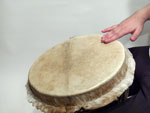 the soft stroke
the soft stroke
: : click to enlarge : : A normal stroke of the fingers near the edge, light, which allows to give a continuous flow of single stroke roll (regular alternation of right hand and left hand), and the illusion of a first voice in the background. This stroke is optional, especially if the group consists of many djembe players. This is in the opposite a technique widely used by djembe Folas (solos). - 2: The slap (high pitch stroke "fortissimo", "claqué" in French): :
-
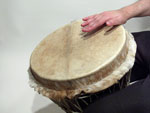 The slap
The slap
: : click to enlarge : : A powerful stroke, hitting the edge of the drum with the palm and letting fingers, flexible project their tips against the skin (similar to congas slap, the djembe slap is made with straight and tight fingers in the extension of the hand, and letting bounce and resonate because in this location of striking, close to the edge, the tone is high and dry anyway). - 3: The resonant medium stroke ("open tone", "tonic" in French): :
-
 open tone
open tone
: : click to enlarge : : you get it by striking with all joint fingers surface, one third of distance from the edge (the place more resonant but not the lowest given the flared shape of the shell). - 4: The muffled low stroke ("bass tone"): :
-
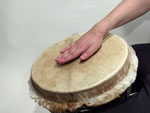 bass tone
bass tone
: : click to enlarge : : Obtained through a stroke with all the hand flat (palm and fingers) in the center of the skin. The lowest hit, but not the most resonant because vibrations, equidistant from the edge, bounce ones against each others and cancel.
Some djembe Folas, use muffled strokes (by pressing the fingers or hand or holding the rebound), to embellish their "discourse". You should also know that the djembe offers an almost infinite number of tones depending on approaching the center of the skin or not, a bit like a violin string, depending on where you press it.
The basic phrase of djembe, found in almost all binary polyrhythms Mandingo is commonly called the "beguine" and is found in various forms in all music of African origin (rumba, samba, calypso, Arabic music , Andalusian, Creole music, etc ...). It is very close to the rhythm of Cuban "bongos" and mark the time ("beat") by high notes (slaps):
(Ta = right hand slap; ka= left hand slap; du = open tone right hand; gu= open tone left hand; - = silence.).
This way of marking beats by the high notes, which gives the impression that we play "in the air" (the dancer foot up, "offbeat") is another common feature of all African-inspired music, opposed to European and Asian music, which mark, in contrast, usually measure beginnings by low instruments and notes (double bass, bass, bass drum, helicon, etc ...).
Each Mandingo polyrhythm has also a second different voice (accompanying pattern) for djembes, in addition to a different pattern per dunun and bell (3 of each). It is on this accompanying basis that the soloist improvises choruses.
 In principle, each player of a band is supposed to perform his solo in turn, which gives a highly "democratic" nature to this type of music. It is a principle that is found in all African-inspired music, in jazz and even sometimes in rock or pop music.
In principle, each player of a band is supposed to perform his solo in turn, which gives a highly "democratic" nature to this type of music. It is a principle that is found in all African-inspired music, in jazz and even sometimes in rock or pop music.
Marc De Douvan, October 2005, translation in English: April 2013.
© 2005 Marc de Douvan Crédits Mentions légales

